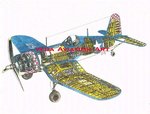FLYBOYJ
"THE GREAT GAZOO"
Magister said:FLYBOY,
What is your opinion on fabric vs. aluminum on control surfaces with respect to holding up to heavy machine gun and cannon fire?
When you punch holes in fabric, it will tear, especially at very high speeds (above 250 mph) and especially on a surface where there could be negative aerodynamic pressures (like a control surface). Even if a machine gun or cannon round goes right through fabric covered structure, you'll get the same reults. When the control surface looses enough fabric, it no longer works, you loose control at the axis that control surface "controls."
Metal surfaces, although thin are a lot more resilient. Back in the day metalized control surfaces were made from "24T" aluminum which was really 2024 T3 or T6 depending on the manufacturer. Again, I would believe metalized surfaces would be a hell of a lot more resilient than fabric surfaces unless you had cannon rounds "exploding" on them upon impact, but then again, a well place cannon shell could do the same thing on a fabric covered control surface if the round impacts a more rigid portion of the structure...



